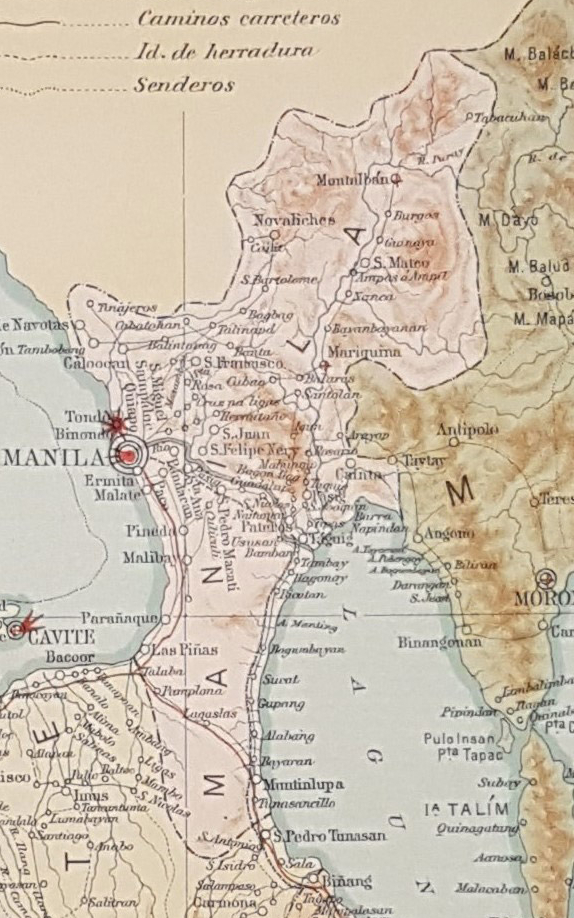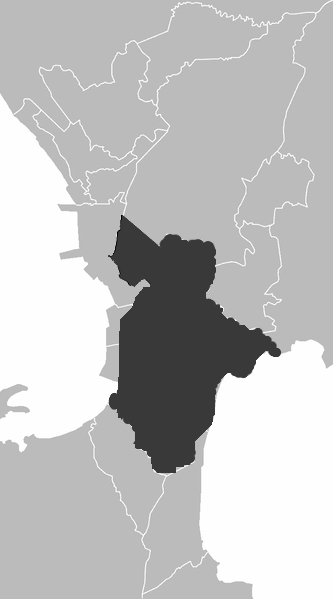|
1st District Of Rizal
The legislative districts of Rizal are the representations of the province of Rizal in the various national and local legislatures of the Philippines. At present, the province is represented in the House of Representatives of the Philippines by its four congressional districts, with the districts' representatives being elected every three years. Additionally, each district is allotted a certain number of seats in the Rizal Provincial Board, with board members also being elected every three years. The component city of Antipolo is represented independently from the province by its own two districts, although it is also represented in the provincial board. History Areas now under the jurisdiction of Rizal were represented under the at-large districts of the province of Manila and Morong in the Malolos Congress from 1898 to 1899. Rizal, established in 1901, was initially divided into two representative districts from 1907 to 2022. From 1907 to 1972, the present-day munici ... [...More Info...] [...Related Items...] OR: [Wikipedia] [Google] [Baidu] |
Rizal Districts 2022
Rizal, officially the Province of Rizal ( fil, Lalawigan ng Rizal), is a province in the Philippines located in the Calabarzon region in Luzon. Its capital is the city of Antipolo. It is about east of Manila. The province is named after José Rizal, one of the main national heroes of the Philippines. Rizal is bordered by Metro Manila to the west, Bulacan to the north, Quezon to the east and Laguna to the southeast. The province also lies on the northern shores of Laguna de Bay, the largest lake in the country. Rizal is a mountainous province perched on the western slopes of the southern portion of the Sierra Madre mountain range. Pasig served as its capital until 2008, even it became a part of the newly created National Capital Region since November 7, 1975. A provincial capitol has been in Antipolo since 2009, making it the administrative center. On June 19, 2020, President Rodrigo Duterte signed Republic Act No. 11475, which designated Antipolo as the capital of Rizal. The cha ... [...More Info...] [...Related Items...] OR: [Wikipedia] [Google] [Baidu] |
Malabon
Malabon, officially the City of Malabon ( fil, Lungsod ng Malabon), is a 1st class highly urbanized city in the National Capital Region of the Philippines. According to the 2020 census, it has a population of 380,522 people. Located just north of the city of Manila, it is primarily a residential and industrial area, and is one of the most densely populated cities in the metropolis. It has a total land area of 15.96 square kilometers. Malabon is part of the sub-region of Metro Manila informally called CAMANAVA, an area which derives its name from the first syllable of its component cities: Caloocan, Malabon, Navotas, and Valenzuela. Caloocan lies to the south and east, Navotas to the west, and Valenzuela to the north. Malabon also borders the town of Obando in the province of Bulacan to the northwest. History Legend considers the city's name to be a contraction of the Tagalog phrase ''maráming labóng'' ("plenty of bamboo shoots"), as the place once abounded in this edible ... [...More Info...] [...Related Items...] OR: [Wikipedia] [Google] [Baidu] |
Philippines's 4th Senatorial District
Philippines's 4th senatorial district, officially the Fourth Senatorial District of the Philippine Islands ( es, Cuarto Distrito Senatorial de las Islas Filipinas), was one of the twelve senatorial districts of the Philippines in existence between 1916 and 1935. It elected two members to the Senate of the Philippines, the upper chamber of the bicameral Philippine Legislature under the Insular Government of the Philippine Islands for each of the 4th to 10th legislatures. The district was created under the 1916 Jones Law from the capital Manila and adjacent provinces in south-central Luzon, namely Bataan, Laguna and Rizal. The district was represented by a total of seven senators throughout its existence. It was abolished in 1935 when a unicameral National Assembly was installed under a new constitution following the passage of the Tydings–McDuffie Act which established the Commonwealth of the Philippines. Since the 1941 elections when the Senate was restored after a constituti ... [...More Info...] [...Related Items...] OR: [Wikipedia] [Google] [Baidu] |
Philippine Legislature
The Philippine Legislature was the legislature of the Philippines from 1907 to 1935, during the American colonial period, and predecessor of the current Congress of the Philippines. It was bicameral and the legislative branch of the Insular Government. From 1907 to 1916, under the Philippine Organic Act of 1902, the legislature's lower house was the elected Philippine Assembly and its upper house was the appointed Philippine Commission, headed by the American governor general (who also served as the executive of the Insular Government). In 1916, the Jones Law abolished the Philippine Commission and reorganized the Philippine Legislature as a fully elected, bicameral legislature composed of the Senate and House of Representatives, precursors to current Senate of the Philippines and House of Representatives of the Philippines. In 1935, the Commonwealth of the Philippines was established and the National Assembly of the Philippines replaced the Philippine Legislature. Histo ... [...More Info...] [...Related Items...] OR: [Wikipedia] [Google] [Baidu] |
Senate Of The Philippines
The Senate of the Philippines (Filipino: ''Senado ng Pilipinas'', also ''Mataas na Kapulungan ng Pilipinas'' or "upper chamber") is the upper house of Congress of the bicameral legislature of the Philippines with the House of Representatives as the lower house. The Senate is composed of 24 senators who are elected at-large (the country forms one district in its elections) under plurality-at-large voting. Senators serve six-year terms with a maximum of two consecutive terms, with half of the senators elected in staggered elections every three years. When the Senate was restored by the 1987 Constitution, the 24 senators who were elected in 1987 served until 1992. In 1992 the 12 candidates for the Senate obtaining the highest number of votes served until 1998, while the next 12 served until 1995. Thereafter, each senator elected serves the full six years. From 1945 to 1972, the Senate was a continuing body, with only eight seats up every two years. Aside from having its concur ... [...More Info...] [...Related Items...] OR: [Wikipedia] [Google] [Baidu] |
Taguig
Taguig (), officially the City of Taguig ( fil, Lungsod ng Taguig), is a 1st class highly urbanized city in Metro Manila, Philippines. According to the 2020 census, it has a population of 886,722 people. Located in the northwestern shores of Laguna de Bay, the city is known for Bonifacio Global City, one of the leading financial centers of the Philippines. Originally a fishing village during the Spanish and American colonial periods, it experienced rapid growth when former military reservations were converted by the Bases Conversion and Development Authority (BCDA) into mixed-use planned communities. Taguig became a highly urbanized city with the passage of Republic Act No. 8487 in 2004. The city is politically subdivided into 28 barangays: Bagumbayan, Bambang, Calzada, Central Bicutan, Central Signal Village, Fort Bonifacio, Hagonoy, Ibayo Tipas, Katuparan, Ligid Tipas, Lower Bicutan, Maharlika Village, Napindan, New Lower Bicutan, North Daang Hari, North Signal Village, ... [...More Info...] [...Related Items...] OR: [Wikipedia] [Google] [Baidu] |
San Juan, Metro Manila
San Juan, officially the City of San Juan ( fil, Lungsod ng San Juan), is a 1st class highly urbanized city in the National Capital Region of the Philippines. According to the 2020 census, it has a population of 126,347 people. It is geographically located at Metro Manila's approximate center and is also the country's smallest city in terms of land area. The city is known historically for the site of the first battle of the Katipunan, the organization which led the 1896 Philippine Revolution against the Spanish Empire. Notable landmarks today such as Pinaglabanan Shrine and heritage homes are located in the city. Other locations include Greenhills and Santolan Town Plaza, making the city a major shopping hub with a range of upscale, boutique and bargain retail. Etymology "San Juan" is a contraction of the city's traditional name of "San Juan del Monte" (). As with numerous other places in the Philippines, the name combines a patron saint and a toponym; in this case Saint Joh ... [...More Info...] [...Related Items...] OR: [Wikipedia] [Google] [Baidu] |
Quezon City
Quezon City (, ; fil, Lungsod Quezon ), also known as the City of Quezon and Q.C. (read in Filipino as Kyusi), is the List of cities in the Philippines, most populous city in the Philippines. According to the 2020 census, it has a population of 2,960,048 people. It was founded on October 12, 1939, and was named after Manuel L. Quezon, the List of presidents of the Philippines, second president of the Philippines. The city was intended to be the Capital of the Philippines, national capital of the Philippines that would replace Manila, as the latter was suffering from overcrowding, lack of housing, poor sanitation, and traffic congestion. To create Quezon City, several barrios were carved out from the towns of Caloocan, Marikina, San Juan, Metro Manila, San Juan and Pasig, in addition to the eight vast estates the Philippine government purchased for this purpose. It was officially proclaimed as the national capital on October 12, 1949, and several government departments and i ... [...More Info...] [...Related Items...] OR: [Wikipedia] [Google] [Baidu] |
Pasig
Pasig, officially the City of Pasig ( fil, Lungsod ng Pasig), is a 1st class highly urbanized city in the National Capital Region of the Philippines. According to the 2020 census, it has a population of 803,159 people. It is located along the eastern border of Metro Manila with Rizal province, the city shares its name with the Pasig River. A formerly rural settlement, Pasig is primarily residential and industrial, but has been becoming increasingly commercial in recent years, particularly after the construction of the Ortigas Center business district in its west. The city is home to the Roman Catholic Diocese of Pasig, based in Pasig Cathedral, a landmark built around the same time as the town's foundation in 1573. Pasig was formerly part of Rizal province before the formation of Metro Manila, the national capital region of the country. The seat of government of Rizal was hosted in Pasig at the old Rizal Provincial Capitol until a new capitol was opened in Antipolo, within R ... [...More Info...] [...Related Items...] OR: [Wikipedia] [Google] [Baidu] |
Pasay
Pasay, officially the City of Pasay ( fil, Lungsod ng Pasay; ), is a 1st class Cities of the Philippines#Legal classification, highly urbanized city in the Metro Manila, National Capital Region of the Philippines. According to the 2020 census, it has a population of 440,656 people. Due to its location just south of Manila, Pasay quickly became an urban town during the History of the Philippines (1898–1946), American colonial period. History Early history In local folk history about the period before the arrival of Spanish colonizers, Pasay is said to have been part of Namayan (sometimes also called Sapa), a confederation of Barangay state, barangays which supposedly controlled territory stretching from Manila Bay to Laguna de Bay, and which, upon the arrival of the Spanish, eventually became known as Santa Ana de Sapa (modern day Santa Ana, Manila). According to these legends, the ruler of Namayan bequeathed his territories in what is now Culi-culi, Pasay, and Baclaran t ... [...More Info...] [...Related Items...] OR: [Wikipedia] [Google] [Baidu] |
Parañaque
Parañaque, officially the City of Parañaque ( fil, Lungsod ng Parañaque, ), is a first class Cities of the Philippines#Legal classification, highly urbanized city in the Metro Manila, National Capital Region of the Philippines. According to the 2020 census, it has a population of 689,992 people. It is bordered to the north by Pasay, to the northeast by Taguig, to the southeast by Muntinlupa, to the southwest by Las Piñas, and to the west by Manila Bay. Like the rest of Metro Manila, Parañaque experiences a tropical climate with only two distinct seasons, wet (July to September) and dry (October to June). The city enjoys an annual rainfall of and an average daily maximum temperature of . Parañaque is the home of the PAGCOR Entertainment City, a gaming and entertainment complex under development by the state owned Philippine Amusement and Gaming Corporation spanning an area of in Bay City, Metro Manila, Bay City, where four large integrated resorts are based namely Solaire ... [...More Info...] [...Related Items...] OR: [Wikipedia] [Google] [Baidu] |
Navotas
Navotas, officially the City of Navotas ( fil, Lungsod ng Navotas), is a 1st class highly urbanized city in the National Capital Region of the Philippines. According to the 2020 census, it has a population of 247,543 people. It is known as the ''Commercial Fishing Hub of the Philippines'', for the city has the third largest fish port in Asia and the largest in Southeast Asia. Although it was established on December 20, 1827, Navotas celebrates its foundation day every January 16, the day in 1906 when it finally separated from Malabon. Navotas became a highly urbanized city on June 24, 2007. Etymology The entire region of Navotas was once part of Malabon. According to one legend, the long and narrow delta extended unbroken from north to south along the seashore. The strip of land between the former district of Tondo, Manila and this town was eaten away by the sea until an opening was made. Water began to flow through the opening. The geographical change prompted the people to re ... [...More Info...] [...Related Items...] OR: [Wikipedia] [Google] [Baidu] |








